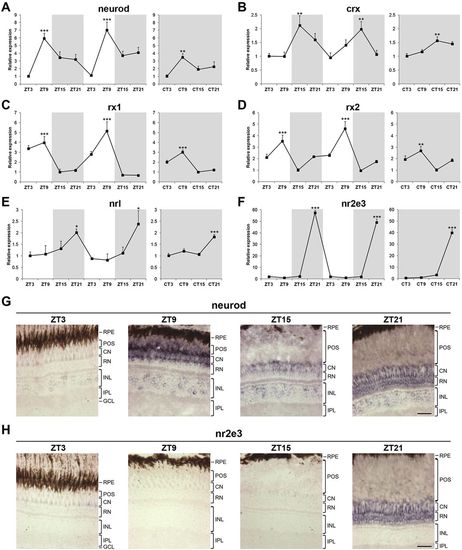Fig. 5
- ID
- ZDB-FIG-140715-3
- Publication
- Laranjeiro et al., 2014 - Transcription factors involved in retinogenesis are co-opted by the circadian clock following photoreceptor differentiation
- Other Figures
- All Figure Page
- Back to All Figure Page
|
Circadian expression of retinal transcription factors is maintained in adult zebrafish. (A-F) qPCR analysis of neurod (A), crx (B), rx1 (C), rx2 (D), nrl (E) and nr2e3 (F) expression in adult eyes over two days of an LD cycle and one subsequent day of DD (n=3-4). Zeitgeber time (ZT) or circadian time (CT) indicates the four time points analysed per day. White and grey backgrounds represent light and dark phases, respectively. Statistically significant differences between the expression peak and trough on each day (Fisher′s LSD test) are indicated: *P<0.05, **P<0.01, ***P<0.001. Error bars indicate s.e.m. (G,H) Representative images of in situ hybridisation for neurod (G) and nr2e3 (H) on adult eye sections at four time points. Note that expression in the photoreceptors at ZT21 is restricted to rods for both neurod and nr2e3. The signal present in the layer of cone nuclei corresponds to rod inner segments that connect the rod nuclei to the rod outer segments. RPE, retinal pigment epithelium; POS, photoreceptor outer segments; CN, cone nuclei; RN, rod nuclei; INL, inner nuclear layer; IPL, inner plexiform layer; GCL, ganglion cell layer. Scale bars: 30μm. |

